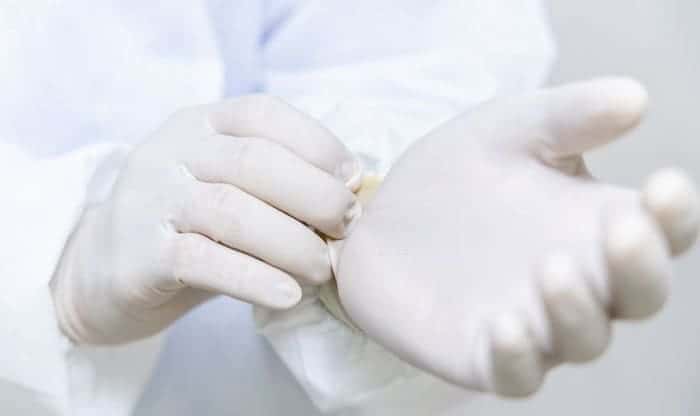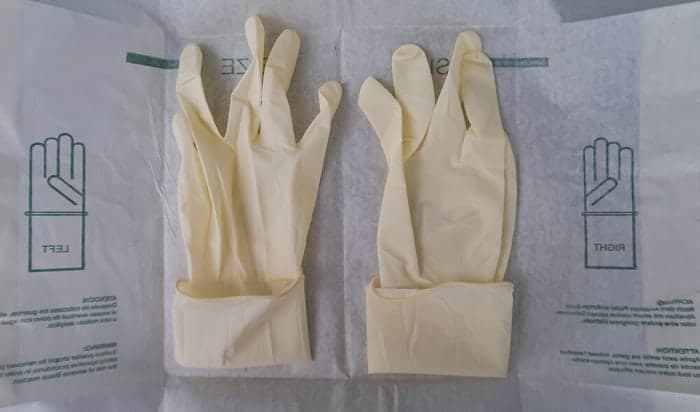The world population is 7.9 billion, but surprisingly, we use approximately 100 billion medical gloves each year, and that is in the medical field alone. In fact, medical gloves are not only imperative to the medical business but also many other industries, such as food production, chemical handling procedures, and even police investigating processes.
They act as a physical barrier that prevents bacteria transmission among individuals, and keep police from messing up fingerprints at crime scenes. Moreover, during the ongoing pandemic, many people choose to wear medical gloves when going out to protect themselves from the virus.
As the demand rises, mass production of medical gloves has been made by large factories. But how are latex gloves made? Briefly, hand-shaped molds are dipped in a natural rubber mixture. The molds are then dried and cleaned with special techniques. Once gloves are formed, they will be removed off the molds. Finally, the gloves undergo extremely strict testing procedures before being packed and shipped.
In this article, I will give detailed explanations on the making of latex gloves, their quality-control phases, and more importantly, useful information to prevent latex allergy when you use medical gloves. Dive in!
Table of Contents
A Brief History of Medical Gloves
As said in an article published by Science History Institute, before medical gloves were invented, doctors used to wash their hands with soap, then dip them into different solutions of potassium, acid, and chlorine to guarantee hand hygiene. However, this hand sanitizing process was highly harmful to doctors’ and nurses’ hands.
That was when medical gloves came in. According to Johns Hopkin Medicine, in 1894, the hospital’s first chief surgeon developed and introduced surgical gloves in America. His name was William Stewart Halsted, and he was widely known as the father of medical gloves.
Nowadays, medical gloves are made of many different materials. The most popular ones are latex, nitrile, and vinyl. Each one has their own advantages and disadvantages. For example, gloves made of nitrile and latex are more elastic than vinyl, but vinyl gloves are more cost-effective. And latex gloves can cause allergies if you are allergic to natural rubber.
Despite causing allergies, latex gloves are used widely. It is because latex is stronger than other materials, so it can provide better protection against tears or splits. Also, latex has an excellent stretchy nature, which helps a lot in tasks that require dexterity. Thus, what is the latex gloves manufacturing process?
How are Latex Gloves Made
Even though there are several types of rubber gloves on the market, the procedures to manufacture them are quite similar. Latex gloves are made of natural rubber.
Firstly, natural rubber is harvested and preserved, then transported to factories. Then, workers will concentrate and purify natural rubber to remove all residues, sediments, and water. The final step is to mix that purified natural rubber with additional chemicals. The mixture is now called latex, and ready to use for production.
Rubber glove factories might be creepy, but the process is oddly satisfying. Here are the general phases factories use to produce gloves.
- Preparing the molds: To start, dozens of ceramic or aluminum molds (by molds, I mean creepy hand-shaped figures) are dipped in hot water, then chlorine or bleach. This is to remove all potential residue from the previous production. Once they are cleaned and dried, they are dipped into a solution of calcium nitrate and calcium carbonate. This process is meant to apply a layer that helps with glove coagulation, making it easier to peel gloves off the molds later on. When the solution dries, the molds are good to go.
- Forming gloves: Now, do you remember the latex mixture from natural rubber I’ve talked about? The hand-shaped molds will dip into tanks containing that mixture. It is so oddly satisfying to watch this process, the youtube channel Insider made an excellent video inside glove factories, watch it here: How rubber gloves are made. How thick the gloves are depends on how long the molds stay in the tank of mixture.
- Removing excess and cleaning: Once the forms are out, they spin themselves to remove any excess rubber or chemicals. To strengthen the rubber, factories will bake the gloves in an oven instead of air drying them. Following that, they will be washed with hot water and chlorine. Again, a second drying process takes place. After being dried, the gloves are formed on the hand molds. Lastly, the forms will spin through brushes, not to do further cleaning this time, but to roll up the gloves’ cuffs. This final process will make it easier to take gloves off the molds.
- Removing the gloves: Latex gloves are usually removed using air pressure. In some traditional factories, they are removed manually by workers.
You might think the gloves are now good to go onto the market. But it doesn’t stop there, the gloves will now be tested with extremely strict procedures. Well, I have to admit glove making processes are a little intense.
How Do Factories Control the Quality
According to the FDA standards, the acceptable quality level (AQL) of medical gloves is from 1.5 to 2.5. It means maximally, only 2.5% of gloves produced might fail the test, or else, the whole batch must be destroyed. Meanwhile, that of sterilized surgical gloves is stricter, from 1.0 to 1.5, which means maximally, 1.5% of sterile gloves on the market might have pinholes. There are two quality-control phases applied to medical gloves to test for pinhole leaks.
The first phase is to make sure the glove stands no risk of leaking air. The testing technique is to fill each glove with air and check for pinholes. You can imagine the gloves being blown up like balloons. The second phase is to ensure the glove stands no risk of leaking liquid. Workers will fill that glove with water and watch for at least two minutes. There must be no leak during the regulatory time for the glove to pass this test.
Besides these two tests that must be performed on each glove, there are other regulatory tests manufacturers must carry out to meet medical-related product standards. First of all, it is a dimension test. In this test, manufacturers must prove their gloves meet standards for the length, width, and thickness of medical gloves. These requirements depend on multiple factors like glove sizes and types.
Secondly, if the glove is marked as sterile, it must pass sterility tests. After that, gloves must be heated at 70-100 degrees C to test their durability and strength. If the glove batch is powdered (this makes it easier to put gloves on and off), the amount of powder applied must be less than 2 mg per glove. Last but not least, latex gloves must be tested for antigenic protein content.
Finally, the gloves are now ready for packaging and shipping. Now that you know how difficult it is for a glove to go onto the market, give your medical gloves extra love whenever you wear them.
Who Shouldn’t Use Latex Gloves
Latex gloves stand chances of causing allergies to the wearers. In fact, Johns Hopkins Medicine, the hospital where medical gloves were born, has become the first institution to eliminate the use of latex gloves. Studies now reveal that estimately 6 percent of the population are allergic to latex. And the longer a person contacts with latex, the higher risk he or she stands to develop natural rubber allergy.
If you are allergic to latex, your body sees natural rubber as a harmful substance. On a light level, it can cause itchy skin or hives. But if you have a serious allergy, it can lead to anaphylaxis, a life-threatening condition in which you experience throat swelling and difficulty breathing. Therefore, any slight symptom of latex allergy should never be taken lightly. If you ever had any bad allergic experience with latex, please consult a doctor before using them. Also, as mentioned above, rubber gloves come in many different materials. You can always use nitrile or vinyl medical gloves instead.
Conclusion
Medical gloves are imperative in our lives. They are everywhere: hospitals, factories, and even in restaurants. Whatever you need medical gloves for, you now have the exact answer of how latex gloves are made. Also, don’t forget to consider carefully before using them if you have an allergy to natural rubber.
I hope you enjoy the article on how are latex gloves made. If you have further questions, feel free to share them in the comment section. I will get to them as soon as I can. See you then!

Having worked in the field of personal protective equipment for over two decades, Andrew Carnegie is a specialist in the field.
At EDC, he strives to improve performance efficiency and promote workplace safety for EDC’s readers and customers. He also researches the most up-to-date equipment that has earned relevant accreditation for use in a wide range of industries and specialties.




